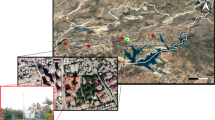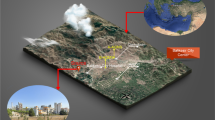Abstract
Measurements of particle size distributions and PM2.5 from an urban background site in the Central Po Valley are analysed; the site is one of the medium–small-size cities in the central valley, without the direct influence of the metropolitan and industrial area of Milan and of the Adriatic Sea. The data comprise number concentration of particle with diameters ranging between 10 and 700 nm, PM2.5 and main meteorological variables from February to August 2008. Daily cycles of the observed pollutants are analysed, along with auto-correlation function for particle number concentration and principal component analysis (PCA) of all the available variables; finally, the diurnal pattern of PM2.5 low-, medium- and high-pollution events has been investigated. Total particle number concentration showed a daily pattern both in winter and summer, although different between weekdays and Sundays and with wider variations during the cold season. A daily cycle is present for the geometric mean diameter of nucleation mode particles in winter and of nucleation and Aitken mode particles in summer. PM2.5 showed a slight daily pattern for weekdays and Sundays, similar, but lagged, to total particle count cycle. Mixing layer depth resulted the main process controlling PM2.5, although also human activities contribute to PM2.5 concentration and allow some deposition and (re-)mobilisation at the first hours of the day and morning rush hour, respectively, while particle number concentration responds immediately to anthropogenic sources. PCA confirmed the dependence of particle number concentration also on meteorological variables, e.g. mixing layer height, wind speed or atmospheric pressure, showing the important influence of regional meteorology on local pollution conditions. Modena can be considered a representative test area of the effect of the meteorological regime for the Central Po Valley on atmospheric particle concentration patterns, characterised by steady high-background concentration.







Similar content being viewed by others
References
ARPA. (2008). Air quality network management committee for the Modena province, Air quality in the Modena province. 18th annual report, pp 84 (in Italian). Accessed at: http://www.arpa.emr.it/cms3/documenti/_cerca_doc/aria/modena/report_annuali/report%20sintetico%202008/RelazAria2008.pdf; last accessed on Dec 20th 2010
Baltensperger, U., Streit, N., Weingartner, E., Nyeki, S., Prévôt, A. S. H., Van Dingenen, R., et al. (2002). Urban and rural aerosol characterization of summer smog events during the PIPAPO field campaign in Milan, Italy. Journal of Geophysical Research, 107(D22), 1–6.
Bigi, A., & Harrison, R. M. (2010). Analysis of the air pollution climate at a central urban background site. Atmospheric Environonment, 16, 2004–2012.
Costabile, F., Birmili, W., Klose, S., Tuch, T., Wehner, B., Wiedensohler, A., et al. (2009). Spatio-temporal variability and principal components of the particle number size distribution in an urban atmosphere. Atmospheric Chemistry and Physics, 9, 3163–3195.
Givati, A., & Rosenfeld, D. (2007). Possible impacts of anthropogenic aerosols on water resources of the Jordan River and the Sea of Galilee. Water Resources Research, 43, W10419.
Gong, D. Y., Ho, C. H., Chen, D., Qian, Y., Choi, Y. S., & Kim, J. (2007). Weekly cycle of aerosol-meteorology interaction over China. Journal of Geophysical Research, D112, 22202.
Grover, B. D., Kleinman, M., Eatough, N. L., Eatough, D. J., Hopke, P. K., Long, R. W., et al. (2005). Measurement of total PM2.5 mass (nonvolatile plus semivolatile) with the filter dynamic measurement system tapered element oscillating microbalance monitor. Journal of Geophysical Research, 110(D7), 1–9.
Hamed, A., Joutsensaari, J., Mikkonen, S., Sogacheva, L., Dal Maso, M., Kulmala, M., et al. (2007). Nucleation and growth of new particles in Po Valley, Italy. Atmospheric Chemistry and Physics, 7, 355–376.
Harris, S. J., & Maricq, M. M. (2001). Signature size distributions for diesel and gasoline engine exhaust particulate matter. Journal of Aerosol Science, 2, 749–764.
Hussein, T., Puustinen, A., Aalto, P. P., Mäkelä, J. M., Hämeri, K., & Kulmala, M. (2004). Urban aerosol number size distributions. Atmospheric Chemistry and Physics, 4(2), 391–411.
IPCC, Climate Change. (2007). The Physical Science Basis. Contribution of Working Group I to the Fourth Assessment Report of the Intergovernmental Panel on Climate Change. Cambridge: Cambridge University Press.
ISTAT (National Institute of Statistics). (2001). Census of population and housing. Accessed at: http://dawinci.istat.it/MD/index.html, last accessed on June 25th 2010.
Jackson, J. E. (1991). A user’s guide to principal components. New York: Wiley.
Knutson, E. O., & Whitby, K. T. (1975). Aerosol classification by electric mobility: Apparatus, theory, and applications. Journal of Aerosol Science, 6, 443–451.
Lenschow, P., Abraham, H.-J., Kutzner, K., Lutz, M., Preuß, J.-D., & Reichenbächer, W. (2001). Some ideas about the sources of PM10. Atmospheric Environment, 35, 23–33.
Lonati, G., & Giugliano, M. (2006). Size distribution of atmospheric particulate matter at traffic exposed sites in the urban area of Milan (Italy). Atmospheric Environment, 40(supp 2), 264–274.
Marinoni, A., Cristofanelli, P., Calzolari, F., Roccato, F., Bonafè, U., & Bonasoni, P. (2008). Continuous measurements of aerosol physical parameters at the Mt. Cimone GAW station (2165 m asl, Italy). The Science of the Total Environment, 391(2–3), 241–251.
Morawska, L., Ristovski, Z., Jayaratne, E. R., Keogh, D. U., & Ling, X. (2008). Ambient nano and ultrafine particles from motor vehicle emissions: Characteristics, ambient processing and implications on human exposure. Atmospheric Environment, 42, 8113–8138.
Moreno, T., Lavín, J., Querol, X., Alastuey, A., Viana, M., & Gibbon, W. (2009). Controls on hourly variations in urban background air pollutant concentrations. Atmospheric Environment, 27, 4178–4186.
Oberdörster, G., Oberdörster, E., & Oberdörster, J. (2005). Nanotoxicology: an emerging discipline evolving from studies of ultrafine particles. Environmental Health Perspectives, 113, 823–839.
Petäjä, T., Kerminen, V. M., Dal Maso, M., Junninen, H., Koponen, I. K., Hussein, T., et al. (2007). Sub-micron atmospheric aerosols in the surroundings of Marseille and Athens: physical characterization and new particle formation. Atmospheric Chemistry and Physics, 7, 2705–2720.
Pope, C. A., & Dockery, D. W. (2006). Health effects of fine particulate air pollution: lines that connect. Journal of the Air & Waste Management Association, 56, 709–742.
R Development Core Team. (2008). R: a language and environment for statistical computing. Vienna: R Foundation for Statistical Computing.
Rodríguez, S., Van Dingenen, R., Putaud, J.-P., Dell'Acqua, A., Pey, J., Querol, X., et al. (2007). A study on the relationship between mass concentrations, chemistry and number size distribution of urban fine aerosols in Milan, Barcelona and London. Atmospheric Chemistry and Physics, 7, 2217–2232.
Seinfeld, J. (2008). Black carbon and brown clouds. Nature Geoscience, 1, 15–16.
Van Dingenen, R., Raes, F., Putaud, J.-P., Baltensperger, U., Charron, A., Facchini, M. C., et al. (2004). A European aerosol phenomenology-1: Physical characteristics of particulate matter at kerbside, urban, rural and background sites in Europe. Atmospheric Environment, 38, 2561–2577.
Van Dingenen, R., Putaud, J.-P., Martins-Dos Santos, S., & Raes, F. (2005). Physical aerosol properties and their relation to air mass origin at Monte Cimone (Italy) during the first MINATROC campaign. Atmospheric Chemistry and Physics, 5, 2203–2226.
Viana, M., Kuhlbusch, T. A. J., Querol, X., Alastuey, A., Harrison, R. M., Hopke, P. K., et al. (2008). Source apportionment of particulate matter in Europe: a review of methods and results. Journal of Aerosol Science, 39, 827–849.
Wang, S. C., & Flagan, R. C. (1990). Scanning electrical mobility spectrometer. Aerosols Science and Technology, 13, 230–240.
Wehner, B., & Wiedensohler, A. (2003). Long term measurements of submicrometer urban aerosols: Statistical analysis for correlations with meteorological conditions and trace gases. Atmospheric Chemistry and Physics, 3, 867–879.
Wehner, B., Birmili, W., Gnauk, T., & Wiedensohler, A. (2002). Particle number size distributions in a street canyon and their transformation into the urban-air background: Measurements and a simple model study. Atmospheric Environment, 36, 2215–2223.
Acknowledgements
Alessandro Bigi was supported by the Italian Minister for University and Research under the project PRIN2006. Funds by Emilia-Romagna regional government under the project SIMECH are acknowledged. Authors are thankful to the ARPA-Emilia-Romagna for providing meteorological data and rural PM2.5 data, and to Dr. Carla Barbieri and Dr. Luisa Guerra (ARPA-Modena) for valuable discussions, within the Research Collaboration Agreement “Fine and ultrafine airborne particles monitoring in the Modena District”.
Author information
Authors and Affiliations
Corresponding author
Rights and permissions
About this article
Cite this article
Bigi, A., Ghermandi, G. Particle Number Size Distribution and Weight Concentration of Background Urban Aerosol in a Po Valley Site. Water Air Soil Pollut 220, 265–278 (2011). https://doi.org/10.1007/s11270-011-0752-6
Received:
Accepted:
Published:
Issue Date:
DOI: https://doi.org/10.1007/s11270-011-0752-6




